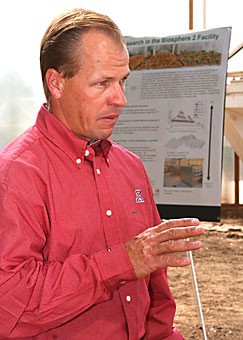Editor’s Note: This is the second part of a two-part series detailing developments in the UA’s operation of Biosphere 2.
In a window-sided corridor under a glass dome in the middle of the Arizona desert, dozens of pinon trees rest in plastic pots.
The trees, along with water sensors, a simulated savannah environment and a team of researchers, could give scientists important information about the death of plants due to drought, as well as a key to understanding how the environment reacts to climate change.
With their controlled environments, the facilities at the Biosphere 2 site are useful in studying the effects of drought and temperature on plants.
Right now, the facility is being used to isolate the trees from factors other than drought that could lead to their death.
The facility allows researchers to experiment on a “”phenomenal spatial scale”” that takes into account complexities of the real world, while also permitting the environmental control found in laboratories, Travis Huxman, director of Biosphere 2 and B2 Earthscience, wrote in an e-mail.
The trees are from northern New Mexico, where a combination of factors, including prolonged drought, bark beetles and pathogens carried by beetles, are killing off trees, said Henry Adams, an ecology and evolutionary biology doctoral student and lead researcher on the experiment.
“”We’re doing this experiment here in Southern Arizona so we can avoid the bark beetles and only look at just the effect of what does it take in terms of drought to kill them,”” Adams said. “”So we’re setting up experimental areas in the biosphere and in the mountains that replicate different temperatures.””
WHERE:
32540 S. Biosphere Road Oracle, Ariz. 85623
WHEN:
Open 9 a.m. to 4 p.m. every day except Christmas Day and Thanksgiving
COST:
Adults $20
Seniors ages 62+ $18
AAA Members $18
Military $18
Children ages 6-12 $13
Children ages under 5 FREE
Half off with CatCard
Adams, along with about half a dozen other students and staff, spent Tuesday morning loading the trees from the Christmas-scented corridor to the back of a pickup truck and driving them to the entrance of the savannah portion of the Biosphere 2.
Thirty of the 50 trees will be put in the Biosphere 2 facility, and the other 20 will be placed in mountains around Tucson, in either the Santa Rita or Catalina ranges, Adams said.
The 20 trees planted in the mountains will be put at two different elevations and will receive either above-average water conditions or no water at all, Adams said.
In some trees, sensors are placed at five different depths in the soil to measure water content, Adams said.
The experiment is scheduled to begin in mid-October and will end when the trees die due to drought, which is estimated to be from six to 18 months, he said.
The movement of water through ecosystems is important in understanding how those ecosystems relate to human sustainability, Huxman said.
“”Water is the most limiting resource on our planet, and more than 40 percent of the earth’s population lives in areas at risk to desertification,”” Huxman said. “”Understanding the behavior of water is the key to tackling big interdisciplinary problems that currently challenge society, such as global climate change.””









